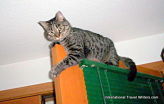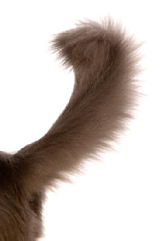Cat Balance -what gives them the edge?

Max and Coty on their terrace rail
Cat balance ...cat info and cat facts on athletic feline behavior. Cat agility is spectacular and our modern domestic cat is a product of its evolution as a hunter also. Cats have evolved over time into animals with a flexible body built for bursts of speed and capable of swiftly changing direction.
However, this efficient body would be nothing without the cat's highly developed cerebellum. The cerebellum is the part of the brain that coordinates messages between the cat's sensory receptors and its muscles, therefore controlling movement. The cat is capable of responding with speed and accuracy along with tremendous cat balance.
Musculature of a cat is more flexible than a dog. The cat's loose muscles, in combination with its backbone, are probably the main reason for the overall flexibility of the cat and cat balance. A cat can arch its back into an inverted "u" shape, curl up in a circle when taking a nap, or rotate one half of its spine almost 180 degrees relative to the other half when necessary.
Coty, our most athletic cat, does unbelievable movements and we tease her that she's an articulated cat like the tandem buses you see that they call articulated buses. You can see a photo of Coty doing this at the top of the Cat Bone Structure page. This rotational ability is important when a cat is righting itself during a fall to regain cat balance.
Cat facts of the skeleton of a cat is it has between 44 and 58 vertebrae...7 neck (cervical), 13 chest (thoracic), 7 back (lumbar), 3 pelvic (sacral), and 14-28 tail (caudal). The average caudal vertebrae is around 14.
Cat Balance is probably the length of the cat's flexible tail relative to its body length that gives it the cat balance capability. Like a tightrope walker using a balancing pole, the cat uses its tail. Movement of the tail muscles is directed by the cerebellum which forwards the messages it receives from the cat's eyes and from a specialized organ of the inner ear...the vestibular apparatus.
The vestibular apparatus is common to all mammals but it may be more developed in the cat. The vestibular apparatus is responsible for cat balance and orientation. By sending information from the inner ear to the animal's brain, the vestibular apparatus informs an animal as to how it is positioned. The brain then sends messages to the animal's body directing it how to respond.
The vestibular apparatus is comprised of a number of fluid-filled chambers (the utricle, the saccule, and the semicircular canals) that are lined with millions of tiny hairs. Whenever these hairs move, signals are transmitted to the brain. The fluid in the larger utricle and saccule chambers contains crystals of calcium carbonate. The position of these crystals signals up and down orientation to the brain.
The semicircular canals are arranged at right angles to one another sort of like a gyroscope. The canals serve as conduits for information on both direction and acceleration in any direction. The tiny hairs in the canals project into flaps of tissue. These flaps move whenever the fluid in the canals moves, sending signals to the brain. The fluid in the canals moves as the cat's head moves.
There is a maxim that cats always land on their feet but this is not exactly true. Cats do possess an ability to right themselves as they fall...the righting reflex...but they may sustain injuries from the fall because it depends on the distance it falls, how fast it falls and what it falls on to.
The righting reflex is an innate trait in a cat. Kittens are born with their vestibular apparatus in working order which is crucial for the righting reflex. But until a kitten opens its eyes, the righting reflex will not be fully operational because it has to be able to relay a message from its eyes to its brain and from its brain to its body.
Cat facts regarding the righting reflex are actually an amazing sequence of events! When a cat begins to fall with its feet higher than its body, the cat turns its body 180 degrees to land on its feet. First, the cat levels its head. Then, the cat turns its head parallel with the ground and rotates its upper chest and front legs. With the cats flexibility, the cat can twist itself so that its front half faces the way it is falling, while its lower half remains pointing upward.
Next, the lower half of the body rotates to line up with the front half. At this point, if the cat misjudges and over twists its lower half, its tail, acting like a rudder, will bring the lower half back on course. The cat is now in a horizontal "flying" position, like a flying squirrel. As the cat comes to land, its flexible back arches to minimize the impact. On landing, its limbs relax to absorb the shock. If all goes well...it has a safe landing.
High-Rise Syndrome refers to the traumatic injuries a cat may suffer when it falls from a considerable height...usually several stories or more. You might assume that the farther a cat falls, the greater the injury. But, after treating a number of cats for high-rise syndrome injuries, the staff of the Animal Medical Center in New York City began to observe an unusual pattern. "We found that cats that fell four stories or less, or ten stories or more, seemed to have the fewest injuries. On the other hand, cats that fell between five and nine stories seemed to have the most serious injuries," said Dr. Michael Garvey, chairman of the Dept. of Medicine at the Center.
Believing that they were onto something, the staff at the Animal Medical Center decided to investigate further. They conducted a study of 132 cats brought in for treatment after high-rise falls. The study results supported the observation that when a cat falls greater distances (more than 10 stories) it does not necessarily sustain greater injury. The study concluded that two factors contribute to this phenomenon: the rate of a falling cat's terminal velocity, and the effects of free-fall on a falling cat.
Velocity...for a definition of velocity we must look to Newtonian physics...whenever a constant force acts on an object, the rate that the object travels will increase over time. So, if an object is traveling toward the ground after a fall, the force of gravity should theoretically cause the object to travel ever faster, second by second, until it hits the ground.
However, this does not happen because the rate of acceleration is interrupted by air resistance (drag), which slows down the moving object. The faster an object moves through the air the more air resistance it encounters, the resistance eventually equals the force acting on it. When this point, terminal velocity is reached, the rate of increase of speed ceases and the rate of travel remains constant as cat balance is tested.
Calculations based on a cat's weight and surface area suggest that the average-sized cat reaches a terminal velocity of 60 miles per hour after falling about 5 stories. So, a cat that falls 105 stories falls no faster than a cat that falls 5 stories.
Free-fall occurs once a cat reaches terminal velocity. Free-fall partly explains why a cat could fall 32 stories and not only survive but walk away relatively unharmed (as did one Animal Medical Center patient) and the innate cat balance factors in as well.
When the vestibular apparatus is no longer stimulated by acceleration, the cat relaxes and takes up a horizontal position similar to a human sky diver in free-fall. In free-fall the body tends to relax.
An outstretched, relaxed, free-falling cat, with its limbs and head slightly trailing its body, will sustain fewer serious injuries as it lands flat on its chest and abdomen than a cat that doesn't have time to right itself or is not relaxed on impact.
However, I must also make a note that a number of cats break their chins upon impact because they are relaxed and their head is not back far enough. Cat balance is still amazing even during unusual circumstances.
Related Articles......
Return from Cat Balance to Cat Health Homepage
Having trouble finding what you need? Cat Health Index & Site Map
OR
Do you have a question to ask?...Questions
OR
Do you have a cat story to share?...Simply click here to go to that page!
Copyright@2010-2020 All rights reserved.Cat-health-detective.com
This website is information only. Consult a veterinarian for medical assistance

"Like Us" on Facebook
or...
"Like Us" here




















